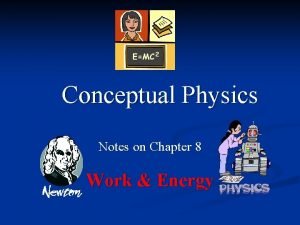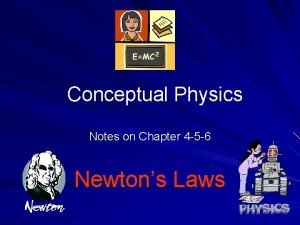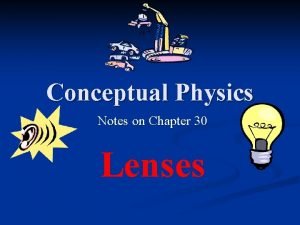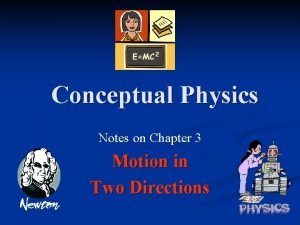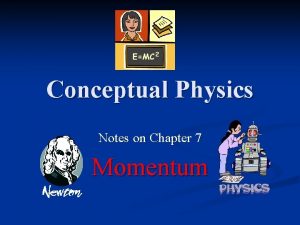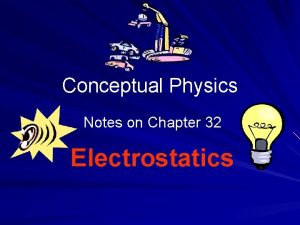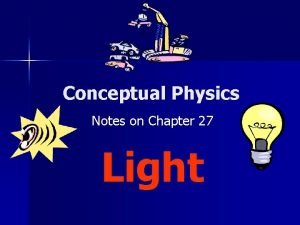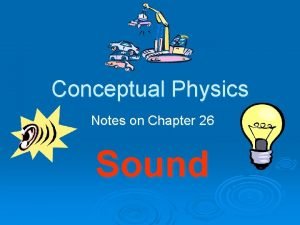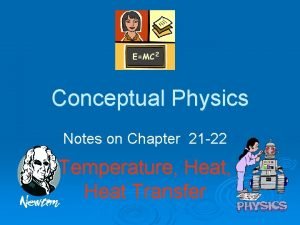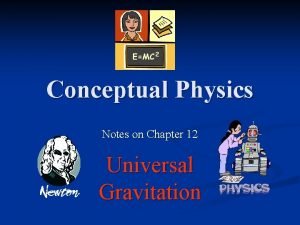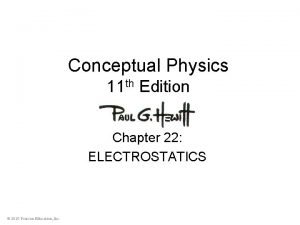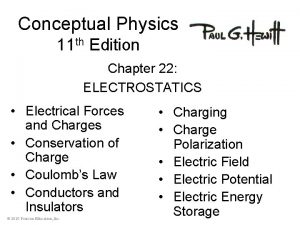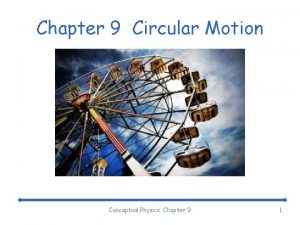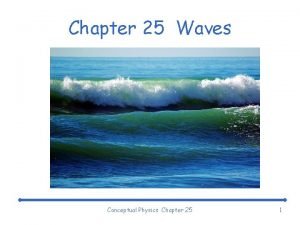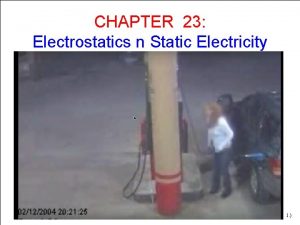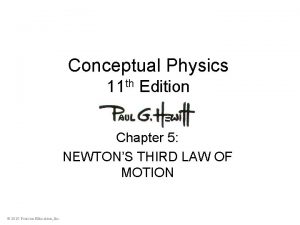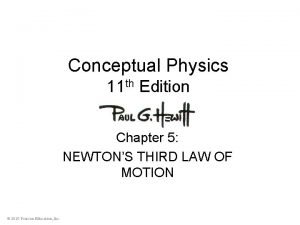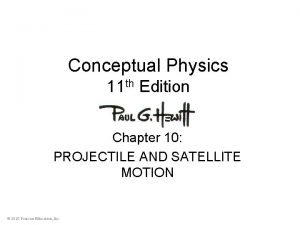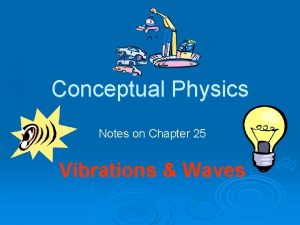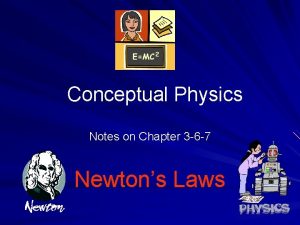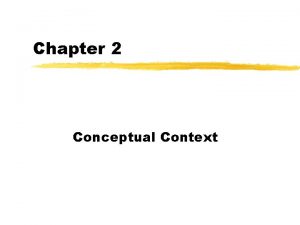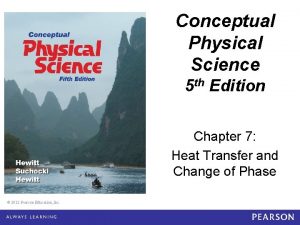Conceptual Physics Notes on Chapter 4 5 6





















- Slides: 21

Conceptual Physics Notes on Chapter 4 -5 -6 Newton’s Laws

Newton’s 1 st Law of Motion Inertia Galileo Aristotle Copernicus THE GREAT THINKERS!

Newton’s 1 st Law of Motion Inertia Aristotle thought of motion in two terms: Violent Motion Natural Motion is motion in the vertical direction. Examples: A tree leaf falls to Earth. Rain falls to Earth Smoke rises into the air Violent Motion is motion in the horizontal direction. Examples: Horse pulling a cart Pushing a rock

Newton’s 1 st Law of Motion Inertia Aristotle thought that if there was NO FORCE, then there was no movement, except for Natural motion Copernicus, looking at astronomical data, reasoned that the Earth was moving around the sun. This went against the church which said Earth was the center of the universe.

Newton’s 1 st Law of Motion Inertia Galileo came up with the definitions of FORCE and FRICTION. Force is any push or pull. Friction is the name given to the force that acts between materials that touch as they move past each other. Galileo was concerned with how things move rather than why they move. Galileo stated that every material resists change --- INERTIA

Newton’s 1 st Law of Motion Inertia Newton’s First Law --- INERTIA Every object continues in a state of rest, or of motion in a straight line at constant speed, unless it is compelled to change that state by forces exerted upon it.

Newton’s 1 st Law of Motion Inertia Mass, Volume and Weight — NOT the same Mass is the amount of matter a object has. Weight is the force of gravity on an object Volume is the amount of space a object takes up.

Newton’s 1 st Law of Motion Inertia Units Mass / Weight is measured in KILOGRAMS (Kg) Volume is measured in CUBIC units (m 3, cm 3, mm 3) Force is measured in NEWTONS (N) One Kg is equal to 9. 8 N Or 9. 8 N is equal to 1 Kg

Newton’s 1 st Law of Motion Inertia Net Force Like vectors we can add and subtract Forces. Net force is equal to the combination of all the forces on a object. (See figure 4. 10 pg 51)

Newton’s 1 st Law of Motion Inertia When all the force on a object are equal, then the object is said to be in equilibrium. Any object in equilibrium is moving at constant speed and direction, or not moving.

Newton’s 2 nd Law of Motion Forces and Motion When a FORCE is applied to a object, that object experiences a acceleration during the applied force When a FORCE is stopped, that object will move at constant speed & constant direction. If I double a force. . I double the acceleration If I triple a force. . I triple the acceleration

Newton’s 2 nd Law of Motion Forces and Motion THEREFORE Force ~ acceleration Mass resists acceleration The larger the mass. . the less the acceleration THEREFORE acceleration ~ 1 / mass

Newton’s 2 nd Law of Motion Forces and Motion Newton’s Second Law acceleration = force / mass Or

Newton’s 2 nd Law of Motion Forces and Motion How I apply a force is PRESSURE Pressure is force per area. Units are Pa. . . Pascal’s

Newton’s 2 nd Law of Motion Forces and Motion Free Fall AGAIN Why do heavy and light objects fall with the same velocity? If you answer g, how do you explain your answer. Newton’s Second Law is a=F/m a=g g = F/m

Newton’s 2 nd Law of Motion Forces and Motion A heavy object has large Force and large Mass F/M A light object has small Force and small Mass F/M then. . . F/M =F/M Notice that the ratio of both equal g

Newton’s 2 nd Law of Motion Forces and Motion What about Air Resistance? a=F/m Force = weight - air resistance (R) a = weight - air resistance / m (Weight = mg) a = mg - R / m (NOTE: m and m are the same) a = g - R (Note that with air resistance the acceleration WILL always be LESS then g )

Newton’s 2 nd Law of Motion Forces and Motion THEREFORE. . a skydiver will always fall less than g. This is known as terminal velocity. Terminal Velocity for – a human is about 150 - 200 km/h a baseball about 45 km/h – a tennis ball about 33 km/h

Newton’s 3 rd Law of Motion Action and Reaction Forces always occur in pairs. . . action – reaction Object A exerts a force on object B Object B exerts a force back on object A

Newton’s 3 rd Law of Motion Action and Reaction Action and reaction forces are equal in strength and opposite in direction Example: The earth pulls on a ball The ball pulls on the earth

Newton’s 3 rd Law of Motion Action and Reaction Question: How does a rocket in outer space move?
 Chapter 8 energy conceptual physics
Chapter 8 energy conceptual physics Conceptual physics chapter 4
Conceptual physics chapter 4 Conceptual physics notes
Conceptual physics notes Conceptual physics chapter 3
Conceptual physics chapter 3 Conceptual physics momentum
Conceptual physics momentum Conceptual physics chapter 35 electric circuits
Conceptual physics chapter 35 electric circuits Conceptual physics chapter 33
Conceptual physics chapter 33 Conceptual physics electrostatics
Conceptual physics electrostatics Conceptual physics chapter 27
Conceptual physics chapter 27 Conceptual physics chapter 26
Conceptual physics chapter 26 Conceptual physics chapter 21
Conceptual physics chapter 21 Conceptual physics chapter 13 universal gravitation
Conceptual physics chapter 13 universal gravitation Conceptual physics chapter 6 momentum
Conceptual physics chapter 6 momentum Conceptual physics chapter 22
Conceptual physics chapter 22 Conceptual physics chapter 22 electrostatics
Conceptual physics chapter 22 electrostatics Chapter 9 circular motion answers
Chapter 9 circular motion answers Conceptual physics chapter 25
Conceptual physics chapter 25 Electricity
Electricity Slightly tilted wings of airplanes deflect
Slightly tilted wings of airplanes deflect Conceptual physics chapter 5 newton's third law of motion
Conceptual physics chapter 5 newton's third law of motion Conceptual physics chapter 3 linear motion
Conceptual physics chapter 3 linear motion Chapter 10 projectile and satellite motion tossed ball
Chapter 10 projectile and satellite motion tossed ball
